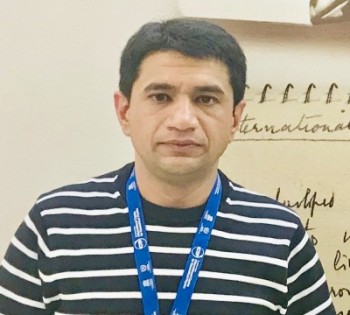[特任研究員]ハシュミ・アルクム

博士(物理学)
現職
東京大学大学院工学系研究科
原子力国際専攻 特任研究員
研究テーマ
Ultrafast femtosecond laser control of electron dynamics in two-dimensional materials
学歴
- PH.D. 2016.02 Pukyong National University South Korea Physics
- Master 2010.06 Bahauddin Zakariya University Pakistan Physics
- Bachelor 2006.10 Bahauddin Zakariya University Pakistan Physics
研究費獲得歴
- JSPS KAKENHI Grant in Aid for Early-Career Scientist, Grant No. 22K13991, 2022
- JSPS KAKENHI Grant in Aid for Early-Career Scientist, Grant No. 19K15381, 2019
- Brain of Korea scholarship in Ph.D. at Pukyong National University, 2014
原著論文
- Hashmi, A.; Yamada, S.; Yamada.; A., Yabana, K.; & Otobe, T. Valley polarization control in WSe2 monolayer by a single-cycle laser pulse. Phys. Rev. B. 2022, 105, 115403.
- Hashmi, A.; Yamada, S.; Yamada.; A., Yabana, K.; & Otobe, T. Nonlinear dynamics of electromagnetic field and valley polarization in WSe2 monolayer. Appl. Phys. Lett. 2022, 120, 051108.
- Hashmi, A.; Nakanishi, K.; Farooq, M. U.; & Ono, T. Ising ferromagnetism and robust half-metallicity in two-dimensional honeycomb-kagome Cr2O3 layer. npj 2D Mater Appl 2020, 4, 1–8.
- Farooq, M. U.; Hashmi, A.; Ono, T.; & Huang, L. Spin–valley Hall phenomena driven by Van Hove singularities in blistered graphene. npj Comput Mater 2020, 6, 1–8.
- Hashmi, A.; Farooq, M. U.; Khan, I.; Son, J.; Hong, J. Ultra-High Capacity Hydrogen Storage in a Li Decorated Two-Dimensional C2N Layer. J. Mater. Chem. A 2017, 5 , 2821–2828.
- Hashmi, A.; Farooq, M. U.; Khan, I.; Hong, J. Two-Dimensional Honeycomb Hafnene Monolayer: Stability and Magnetism by Structural Transition. Nanoscale 2017, 9, 10038–10043.
- Khan, I.; Hashmi, A.; Farooq, M. U.; Hong, J. Two-Dimensional Magnetic Semiconductor in Feroxyhyte. ACS Appl. Mater. Interfaces 2017, 9 (40), 35368–35375.
- Farooq, M. U.; Hashmi, A.; Khan, I.; Hong, J. Superconductivity in two-dimensional ferromagnetic MnB. Scientific Reports 2017, 7, 17101.
- Hashmi, A.; Farooq, M. U.; Hong, J. Long-Range Magnetic Ordering and Switching of Magnetic State by Electric Field in Porous Phosphorene. J. Phys. Chem. Lett. 2016, 7, 647–652.
- Farooq, M. U.; Hashmi, A.; Hong, J. Ferromagnetism Controlled by Electric Field in Tilted Phosphorene Nanoribbon. Scientific Reports 2016, 6, 26300.
- Son, J.; Hashmi, A.; Hong, J. Manipulation of N and P Type Dope Black Phosphorene Layer: A First Principles Study. Current Applied Physics 2016, 16 (5), 506–514.
- Hashmi, A.; Farooq, U.; Hong, J. Graphene/phosphorene Bilayer: High Electron Speed, Optical Property and Semiconductor-Metal Transition with Electric Field. Current Applied Physics 2016, 16 (3), 318–323.
- Hashmi, A.; Hong, J. Transition Metal Doped Phosphorene: First-Principles Study. J. Phys. Chem. C 2015, 119 (17), 9198–9204.
- Hashmi, A.; Farooq, M. U.; Hu, T.; Hong, J. Spin-Dependent Transport and Optical Properties of Transparent Half-Metallic G-C4N3 Films. J. Phys. Chem. C 2015, 119 (4), 1859–1866.
- Umar Farooq, M.; Hashmi, A.; Hong, J. Anisotropic Bias Dependent Transport Property of Defective Phosphorene Layer. Scientific Reports 2015, 5, 12482.
- Hu, T.; Hashmi, A.; Hong, J. Geometry, Electronic Structures and Optical Properties of Phosphorus Nanotubes. Nanotechnology 2015, 26 (41), 415702. Farooq, M. U.; Hashmi, A.;
- Hong, J. Thickness Dependent Optical Properties of Multilayer BN/Graphene/BN. Surface Science 2015, 634, 25–30.
- Farooq, M. U.; Hashmi, A.; Hong, J. Manipulation of Magnetic State in Armchair Black Phosphorene Nanoribbon by Charge Doping. ACS Appl. Mater. Interfaces 2015, 7 (26), 14423–14430.
- Hu, T.; Hashmi, A.; Hong, J. Transparent Half Metallic G-C4N3 Nanotubes: Potential Multifunctional Applications for Spintronics and Optical Devices. Scientific Reports 2014, 4, 6059.
- Hashmi, A.; Hong, J. Magnetic Properties of graphene/BN/Co(111) and Potential Spintronics. Journal of Magnetism and Magnetic Materials 2014, 355, 7–11.
- Hashmi, A.; Hu, T.; Hong, J. Transition from Half Metal to Semiconductor in Li Doped G-C4N3. Journal of Applied Physics 2014, 115 (12), 124312.
- Hashmi, A.; Hong, J. Metal Free Half Metallicity in 2D System: Structural and Magnetic Properties of G-C4N3 on BN. Scientific Reports 2014, 4.
- Hashmi, A.; Hong, J. Band Gap and Effective Mass of Multilayer BN/graphene/BN: Van Der Waals Density Functional Approach. Journal of Applied Physics 2014, 115 (19), 194304.
- Kim, D.; Hashmi, A.; Hwang, C.; Hong, J. Magnetization Reversal and Spintronics of Ni/Graphene/Co Induced by Doped Graphene. Applied Physics Letters 2013, 102 (11), 112403.
学会発表
- Weak and strong field optical response in ultrathin films of topological insulator, 70th JSAP Spring Meeting 2023, 2023-03-15 ~ 2023-03-18.
- Valley polarization in WSe2 monolayer: CEP control of ω and ω+2 ω Pulses, 9th Time-Dependent Density-Functional Theory: Prospects and Applications, Spain, 2022-10-18 ~ 2022-10-28.
- Valley selective excitations in WSe2 monolayer by (ω+ 2ω) pulses, 83rd JSAP autumn Meeting 2022, 2022-09-20 ~ 2022-09-23.
- Sub-cycle control of valley polarization in WSe2 monolayer, 8th International Conference on Attosecond Science and Technology in Physics, ATTO VIII, Orlando Florida, USA. 2022-07-11 ~ 2022-07-15
- Optical Field Control of Electron Dynamics in WSe2 Monolayer. 15th Pacific Rim Conference on Lasers and Electro-Optics (CLEO-PR2022), 2022-07-31 ~ 2022-08-06
- Weak and Strong Field Control of Valley Polarization in WSe2 Monolayer. In Conference on Lasers and Electro-Optics (2022), 2022-05-15 ~ 2022-05-20
- Linear and nonlinear optical response of WSe2 monolayer by chiral resonant pulses, OPTICS & PHOTONICS International Congress 2022, 2022-04-18 ~ 2022-04-22.
- Ultrafast control of the valley and spin polarization in Transition-metal dichalcogenides, 69th JSAP Spring Meeting 2022, 2022-03-22 ~ 2022-03-26
メッセージ
I joined the Prof. Ishikawa theory group because they have outstanding theoretical expertise in the field of light-matter interaction, whether it’s atoms, molecules, or solids. Here researcher can enhance their theoretical understanding of laser-matter interaction through discussions with professors and fellow researchers in a very calm learning environment. The fellow researchers and the staff are very cooperative and they try their best to help you. I’m really enjoying working here. If you are interested in this exciting field, please don’t hesitate to get in touch with Professor Ishikawa.
